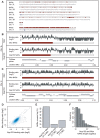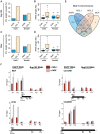Nuclear pore proteins nup153 and megator define transcriptionally active regions in the Drosophila genome
- PMID: 20174442
- PMCID: PMC2820533
- DOI: 10.1371/journal.pgen.1000846
Nuclear pore proteins nup153 and megator define transcriptionally active regions in the Drosophila genome
Abstract
Transcriptional regulation is one of the most important processes for modulating gene expression. Though much of this control is attributed to transcription factors, histones, and associated enzymes, it is increasingly apparent that the spatial organization of chromosomes within the nucleus has a profound effect on transcriptional activity. Studies in yeast indicate that the nuclear pore complex might promote transcription by recruiting chromatin to the nuclear periphery. In higher eukaryotes, however, it is not known whether such regulation has global significance. Here we establish nucleoporins as a major class of global regulators for gene expression in Drosophila melanogaster. Using chromatin-immunoprecipitation combined with microarray hybridisation, we show that Nup153 and Megator (Mtor) bind to 25% of the genome in continuous domains extending 10 kb to 500 kb. These Nucleoporin-Associated Regions (NARs) are dominated by markers for active transcription, including high RNA polymerase II occupancy and histone H4K16 acetylation. RNAi-mediated knock-down of Nup153 alters the expression of approximately 5,700 genes, with a pronounced down-regulatory effect within NARs. We find that nucleoporins play a central role in coordinating dosage compensation-an organism-wide process involving the doubling of expression of the male X chromosome. NARs are enriched on the male X chromosome and occupy 75% of this chromosome. Furthermore, Nup153-depletion abolishes the normal function of the male-specific dosage compensation complex. Finally, by extensive 3D imaging, we demonstrate that NARs contribute to gene expression control irrespective of their sub-nuclear localization. Therefore, we suggest that NAR-binding is used for chromosomal organization that enables gene expression control.
Conflict of interest statement
The authors have declared that no competing interests exist.
Figures





Similar articles
-
Characterization of genome-nucleoporin interactions in Drosophila links chromatin insulators to the nuclear pore complex.Cell Cycle. 2010 Dec 15;9(24):4812-7. doi: 10.4161/cc.9.24.14328. Epub 2010 Dec 15. Cell Cycle. 2010. PMID: 21150273
-
Nuclear pore components are involved in the transcriptional regulation of dosage compensation in Drosophila.Mol Cell. 2006 Mar 17;21(6):811-23. doi: 10.1016/j.molcel.2006.02.007. Mol Cell. 2006. PMID: 16543150
-
Correct dosage of X chromosome transcription is controlled by a nuclear pore component.Cell Rep. 2021 Jun 15;35(11):109236. doi: 10.1016/j.celrep.2021.109236. Cell Rep. 2021. PMID: 34133927 Free PMC article.
-
Dosage Compensation of the X Chromosome: A Complex Epigenetic Assignment Involving Chromatin Regulators and Long Noncoding RNAs.Annu Rev Biochem. 2018 Jun 20;87:323-350. doi: 10.1146/annurev-biochem-062917-011816. Epub 2018 Apr 18. Annu Rev Biochem. 2018. PMID: 29668306 Review.
-
The right dose for every sex.Chromosoma. 2007 Apr;116(2):95-106. doi: 10.1007/s00412-006-0089-x. Epub 2006 Nov 24. Chromosoma. 2007. PMID: 17124606 Free PMC article. Review.
Cited by
-
Core Components of the Nuclear Pore Bind Distinct States of Chromatin and Contribute to Polycomb Repression.Mol Cell. 2020 Jan 2;77(1):67-81.e7. doi: 10.1016/j.molcel.2019.10.017. Epub 2019 Nov 26. Mol Cell. 2020. PMID: 31784359 Free PMC article.
-
Nucleoporins and transcription: new connections, new questions.PLoS Genet. 2010 Feb 26;6(2):e1000861. doi: 10.1371/journal.pgen.1000861. PLoS Genet. 2010. PMID: 20195517 Free PMC article. No abstract available.
-
Interaction of a DNA zip code with the nuclear pore complex promotes H2A.Z incorporation and INO1 transcriptional memory.Mol Cell. 2010 Oct 8;40(1):112-25. doi: 10.1016/j.molcel.2010.09.007. Mol Cell. 2010. PMID: 20932479 Free PMC article.
-
The Tpr protein regulates export of mRNAs with retained introns that traffic through the Nxf1 pathway.RNA. 2011 Jul;17(7):1344-56. doi: 10.1261/rna.2616111. Epub 2011 May 25. RNA. 2011. PMID: 21613532 Free PMC article.
-
Nucleocytoplasmic mRNP export is an integral part of mRNP biogenesis.Chromosoma. 2011 Feb;120(1):23-38. doi: 10.1007/s00412-010-0298-1. Epub 2010 Nov 16. Chromosoma. 2011. PMID: 21079985 Free PMC article. Review.
References
-
- Kouzarides T. Chromatin modifications and their function. Cell. 2007;128:693–705. - PubMed
-
- Li B, Carey M, Workman JL. The role of chromatin during transcription. Cell. 2007;128:707–719. - PubMed
-
- Clapier CR, Cairns BR. The biology of chromatin remodelling complexes. Annu Rev Biochem. 2009;78:273–304. - PubMed
-
- Suganuma T, Workman JL. Crosstalk among histone modifications. Cell. 2008;135:604–607. - PubMed
-
- Lanctôt C, Cheutin T, Cremer M, Cavalli G, Cremer T. Dynamic genome architecture in the nuclear space: regulation of gene expression in three dimensions. Nat Rev Genet. 2007;8:104–115. - PubMed
Publication types
MeSH terms
Substances
LinkOut - more resources
Full Text Sources
Molecular Biology Databases
Miscellaneous

